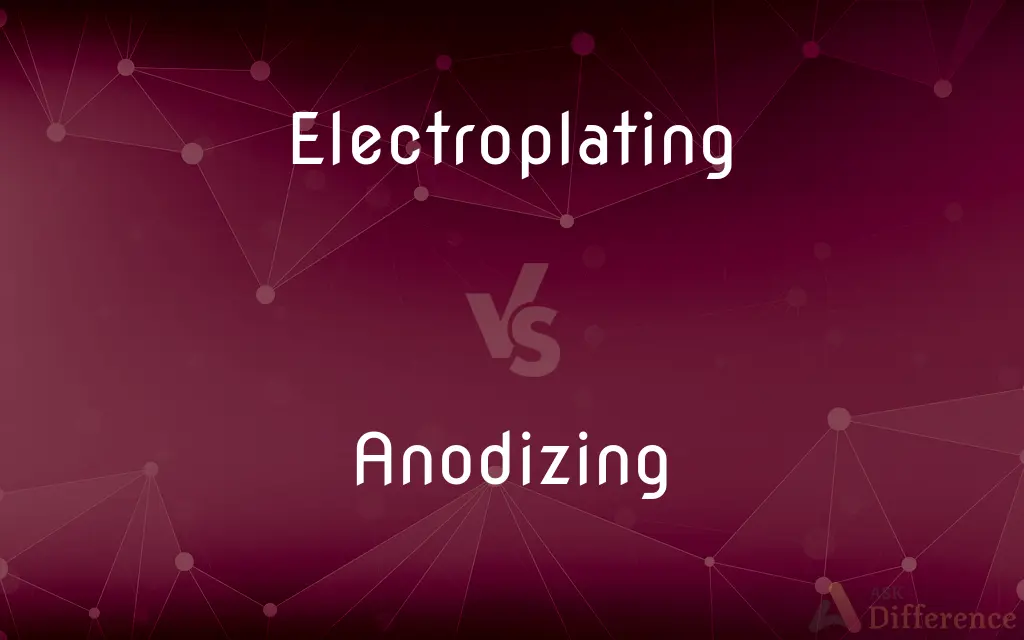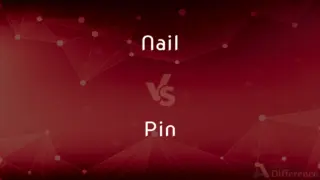Electroplating vs. Anodizing — What's the Difference?
Edited by Tayyaba Rehman — By Fiza Rafique — Updated on April 16, 2024
Electroplating involves depositing a metal layer on a substrate via an electric current, enhancing appearance and corrosion resistance; anodizing uses electrolysis to convert the metal surface into a durable, corrosion-resistant oxide layer.

Difference Between Electroplating and Anodizing
Table of Contents
ADVERTISEMENT
Key Differences
Electroplating utilizes an electrical current to coat a conductive object with a thin layer of metal, such as gold, silver, or nickel, often for aesthetic purposes or to prevent corrosion. In contrast, anodizing is a process specifically used for metals like aluminum, where the surface is converted into its oxide, enhancing durability and wear resistance.
Electroplating requires the object to be dipped in a solution containing the metal to be deposited, which acts as the cathode in an electrolytic cell, while the metal ions in solution form the anode. On the other hand, anodizing involves immersing the metal in an acidic electrolyte and making it the anode, which leads to the formation of the oxide layer directly on the metal surface.
In electroplating, the thickness and quality of the coating can vary greatly and are dependent on the time, current density, and specific conditions of the plating bath. Whereas in anodizing, the resulting oxide layer's thickness and properties are highly controllable through the voltage, temperature, and composition of the anodizing solution.
Electroplating can be used on a variety of metals and non-metals treated to conduct electricity, providing versatility in applications. Conversely, anodizing is primarily used on aluminum, titanium, and some other non-ferrous metals, limiting its applicability but offering specialized enhancements.
The finished surface from electroplating can achieve a decorative finish that can closely resemble the pure metal, offering choices in color and finish. Anodizing, while limited in the spectrum of colors, often results in a more durable and hard finish that is integral to the metal, suitable for high-wear applications.
ADVERTISEMENT
Comparison Chart
Process Type
Electrochemical deposition
Electrochemical conversion
Primary Use
Aesthetic enhancement, corrosion resistance
Durability, corrosion resistance
Substrate Compatibility
Metals and other conductive surfaces
Mainly aluminum, titanium
Color Variability
High (various metals and dyes)
Limited (mostly metallic and anodized colors)
Layer Formation
External metal layer added
Oxide layer formed from the metal itself
Compare with Definitions
Electroplating
A technique used in manufacturing to improve corrosion resistance.
Electroplating iron with zinc protects against rust.
Anodizing
Used to increase surface resistance and durability.
Anodizing is commonly applied in the aerospace industry for enhanced component longevity.
Electroplating
Used decoratively in jewelry and arts.
Electroplating artifacts with gold preserves them and adds aesthetic value.
Anodizing
An electrochemical process that thickens and toughens the naturally occurring protective oxide on aluminum.
Anodizing aluminum parts makes them more resistant to corrosion and wear.
Electroplating
The process of coating a metal object with a thin layer of another metal by electrolysis.
Electroplating silver onto a copper ring enhances its appearance and value.
Anodizing
Often employed to add color to metal surfaces through dyeing.
Anodizing can be used to create blue, red, or green aluminum parts.
Electroplating
A method for adding electrical conductivity to non-metals.
Electroplating carbon fiber with copper allows it to conduct electricity.
Anodizing
Involves an electrical current that forms an oxide layer from the base metal itself.
Anodizing creates a protective finish that is hard and integrates into the metal.
Electroplating
A process utilized in various industries including automotive and electronics.
Electroplating is critical in creating durable and conductive electronic connectors.
Anodizing
A technique that is integral to the production of medical devices.
Anodizing titanium joints increases their biocompatibility and durability.
Electroplating
Electroplating is a general name for processes that create a metal coating on a solid substrate through the reduction of cations of that metal by means of a direct electric current. The part to be coated acts as the cathode (negative electrode) of an electrolytic cell; the electrolyte is a solution of a salt of the metal to be coated; and the anode (positive electrode) is usually either a block of that metal, or of some inert conductive material.
Anodizing
Anodizing is an electrolytic passivation process used to increase the thickness of the natural oxide layer on the surface of metal parts. The process is called anodizing because the part to be treated forms the anode electrode of an electrolytic cell.
Electroplating
To coat or cover with a thin layer of metal by electrodeposition.
Anodizing
To coat (a metallic surface) electrolytically with a protective or decorative oxide.
Electroplating
Present participle of electroplate
Anodizing
Present participle of anodize
Electroplating
A process of coating the surfaces of a metal object with a layer of a different metal through electrochemical means, usually to exploit different properties of the materials.
Electroplating
The art or process of depositing a coating (commonly) of silver, gold, or nickel on an inferior metal, by means of an electric current. The metal to be deposited on an article is usually used as the anode and the article to be plated as the cathode, in an electrolyte solution in which the plating metal is the cation. The process is conducted in a tank called an electroplating bath, which holds the electrolyte solution.
Common Curiosities
What are the environmental impacts of electroplating?
Electroplating can produce hazardous waste and toxic metals, requiring careful handling and disposal.
Is anodizing only suitable for aluminum?
While primarily used for aluminum, anodizing can also be applied to titanium and some other non-ferrous metals.
Can electroplating be done on plastic?
Yes, but the plastic must be made conductive through a sensitizing and activating process first.
What metals can be electroplated?
Most commonly, metals like copper, nickel, silver, and gold are used for electroplating.
How durable is an anodized finish?
Anodized finishes are highly durable and resistant to corrosion and wear, making them suitable for high-wear environments.
What industries use electroplating?
Industries such as automotive, electronics, aerospace, and jewelry frequently use electroplating.
Can the color of an anodized part fade over time?
Yes, particularly if exposed to UV light or harsh chemicals, anodized colors may fade.
Can anodized parts be recycled?
Yes, anodized parts are fully recyclable without any degradation of the metal.
Why is anodizing considered environmentally friendly?
Anodizing uses fewer toxic chemicals than some other processes, and the by-products are often recyclable.
Can anodizing improve electrical insulation?
Yes, the oxide layer produced by anodizing can enhance electrical insulation properties.
What are the limitations of anodizing?
Anodizing is mainly limited to specific metals and cannot provide the lustrous finish typical of some metals like gold or silver through electroplating.
How thick is an anodized layer typically?
An anodized layer can range from 5 micrometers to 25 micrometers thick.
Is electroplating considered a permanent solution?
While it provides a durable coating, electroplating can wear off over time, especially on high-contact surfaces.
How do you remove an electroplated layer?
Electroplated layers can be removed chemically or through abrasive techniques.
What is the role of the electrolyte in electroplating?
The electrolyte in electroplating contains metal ions that are deposited onto the cathode surface.
Share Your Discovery

Previous Comparison
Nail vs. Pin
Next Comparison
Physics vs. MetaphysicsAuthor Spotlight
Written by
Fiza RafiqueFiza Rafique is a skilled content writer at AskDifference.com, where she meticulously refines and enhances written pieces. Drawing from her vast editorial expertise, Fiza ensures clarity, accuracy, and precision in every article. Passionate about language, she continually seeks to elevate the quality of content for readers worldwide.
Edited by
Tayyaba RehmanTayyaba Rehman is a distinguished writer, currently serving as a primary contributor to askdifference.com. As a researcher in semantics and etymology, Tayyaba's passion for the complexity of languages and their distinctions has found a perfect home on the platform. Tayyaba delves into the intricacies of language, distinguishing between commonly confused words and phrases, thereby providing clarity for readers worldwide.















































